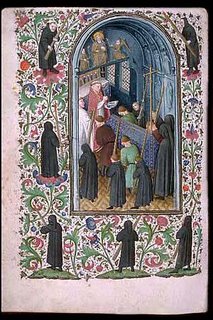
Medieval Spirituality was replete with thoughts of death and the afterlife. Death was all around the average person during the Middle Ages. Life expectancy for males born 1276-1300 was 31.3 years. Females had a 50% higher chance of dying due to childbirth.
Prayer books were often illustrated with scenes whose purpose was to remind the reader of the necessity to amend one's life while there was still time. For example, in the margins of hand drawn illustrations in the Book of the Hours from Belgium, is the Latin inscription, "Memento mori" or "Remember death." The margins were sometimes decorated with skulls and stories of the dead coming back to give the living their own personal reality check from the afterlife.
Illustrations called the "Dance Macabre" were painted on the walls of cemeteries. These "Dances of Death" showed the devil leading a long line of people, including popes, kings, ladies, knights, monks and lepers, into the tomb. According to Our Sunday Visitor newspaper, "Sometimes the dance was presented on All Souls' Day itself as a living tableau with people dressed up in the garb of various stages of life."
The illustration I have here is from Leaves of Gold Gallery. It is called Chanting the Office of the Dead. In it, "A coffin draped with a rich, blue cloth appears inside a church. Pallbearers hold the coffin before a priest who recites the Office of the Dead. In the foliate border, mourners dressed in black hold long, twisted candles."


No comments:
Post a Comment